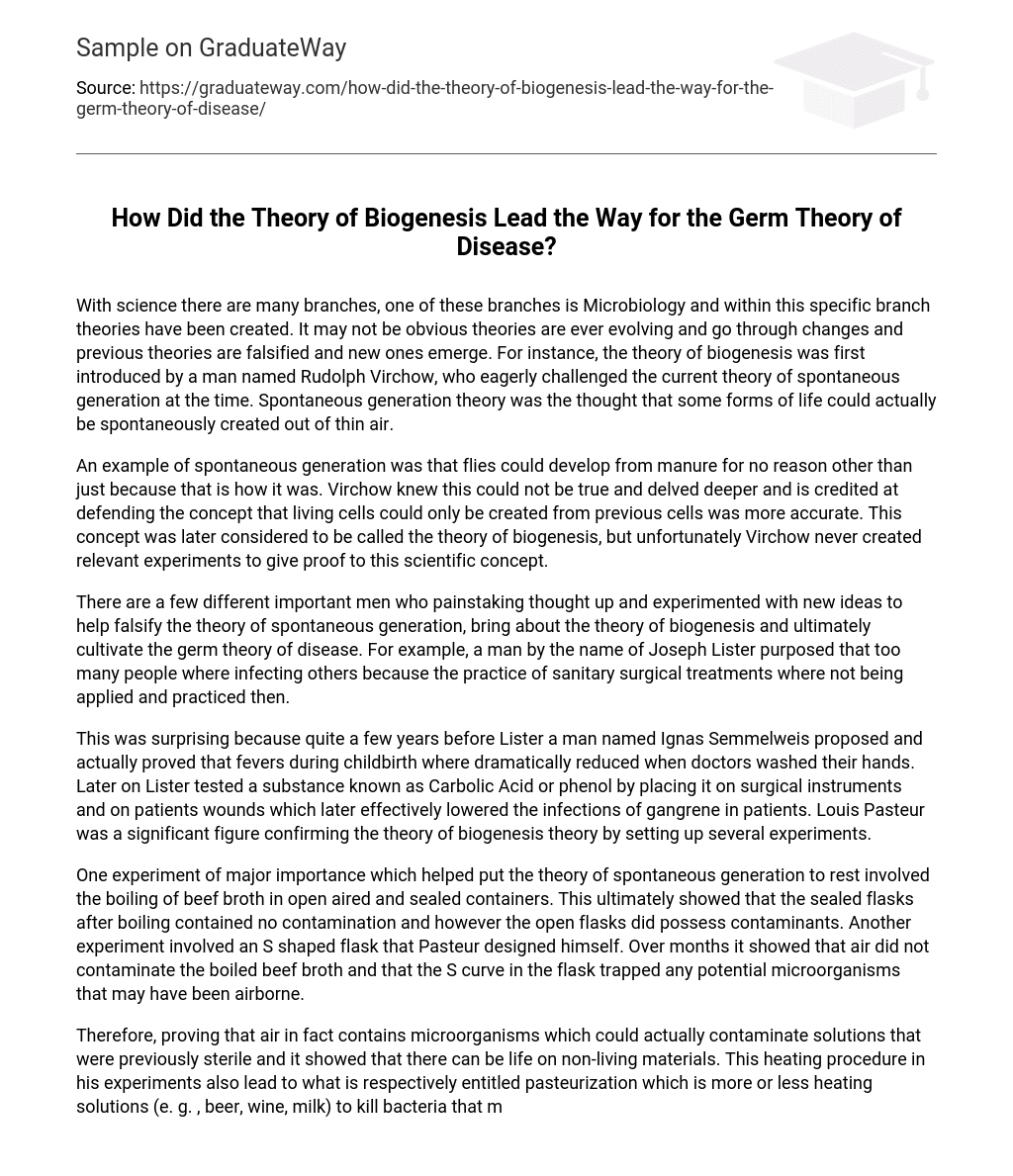With science there are many branches, one of these branches is Microbiology and within this specific branch theories have been created. It may not be obvious theories are ever evolving and go through changes and previous theories are falsified and new ones emerge. For instance, the theory of biogenesis was first introduced by a man named Rudolph Virchow, who eagerly challenged the current theory of spontaneous generation at the time. Spontaneous generation theory was the thought that some forms of life could actually be spontaneously created out of thin air.
An example of spontaneous generation was that flies could develop from manure for no reason other than just because that is how it was. Virchow knew this could not be true and delved deeper and is credited at defending the concept that living cells could only be created from previous cells was more accurate. This concept was later considered to be called the theory of biogenesis, but unfortunately Virchow never created relevant experiments to give proof to this scientific concept.
There are a few different important men who painstaking thought up and experimented with new ideas to help falsify the theory of spontaneous generation, bring about the theory of biogenesis and ultimately cultivate the germ theory of disease. For example, a man by the name of Joseph Lister purposed that too many people where infecting others because the practice of sanitary surgical treatments where not being applied and practiced then.
This was surprising because quite a few years before Lister a man named Ignas Semmelweis proposed and actually proved that fevers during childbirth where dramatically reduced when doctors washed their hands. Later on Lister tested a substance known as Carbolic Acid or phenol by placing it on surgical instruments and on patients wounds which later effectively lowered the infections of gangrene in patients. Louis Pasteur was a significant figure confirming the theory of biogenesis theory by setting up several experiments.
One experiment of major importance which helped put the theory of spontaneous generation to rest involved the boiling of beef broth in open aired and sealed containers. This ultimately showed that the sealed flasks after boiling contained no contamination and however the open flasks did possess contaminants. Another experiment involved an S shaped flask that Pasteur designed himself. Over months it showed that air did not contaminate the boiled beef broth and that the S curve in the flask trapped any potential microorganisms that may have been airborne.
Therefore, proving that air in fact contains microorganisms which could actually contaminate solutions that were previously sterile and it showed that there can be life on non-living materials. This heating procedure in his experiments also lead to what is respectively entitled pasteurization which is more or less heating solutions (e. g. , beer, wine, milk) to kill bacteria that may be causing spoilage. But a man named Robert Koch who was actually a rival of Louis Pasteur’s at the time in the race to find a cure for a disease known as Anthrax, attempted to use specific microorganisms with actual diseases.
These experiments that Pasteur and Koch produced are said to be the pivotal structure of what produced the germ theory of disease, which is the thought that certain diseases result from specific germs. It is interesting to note that the series of steps used by Koch later became known as Koch’s postulates, which are still considered to be a reliable way to categorize specific microorganism with specific diseases. None the less, there are many individuals such as Lister, Pasteur, and Koch who dedicated themselves to science and more specifically microbiology to help falsify theories such as spontaneous generation.
Ultimately, these individuals and their acquiring minds and academic creditability created a foundation for science and helped to discover one of the most important discoveries that aids in the enhancement of human life. As a future medical professional I will need to apply knowledge of antiseptic and sanitary principles in environments in the hospital and medical capacities. I may observe situation such as in a surgical setting that I would need to implement all necessary means to prohibit the likelihood of an infection being transferred to patients.
One important precautionary action is to thoroughly wash hands especially if you are in a surgical setting before entering any type of area where infection could spread. Next, is to always wear latex type medical grade gloves when the possibility of infection could occur especially around wounds. Doing these two simple things will allow me to produce the safest way possible in order to allow possible infection to not spread from me to a patient.





